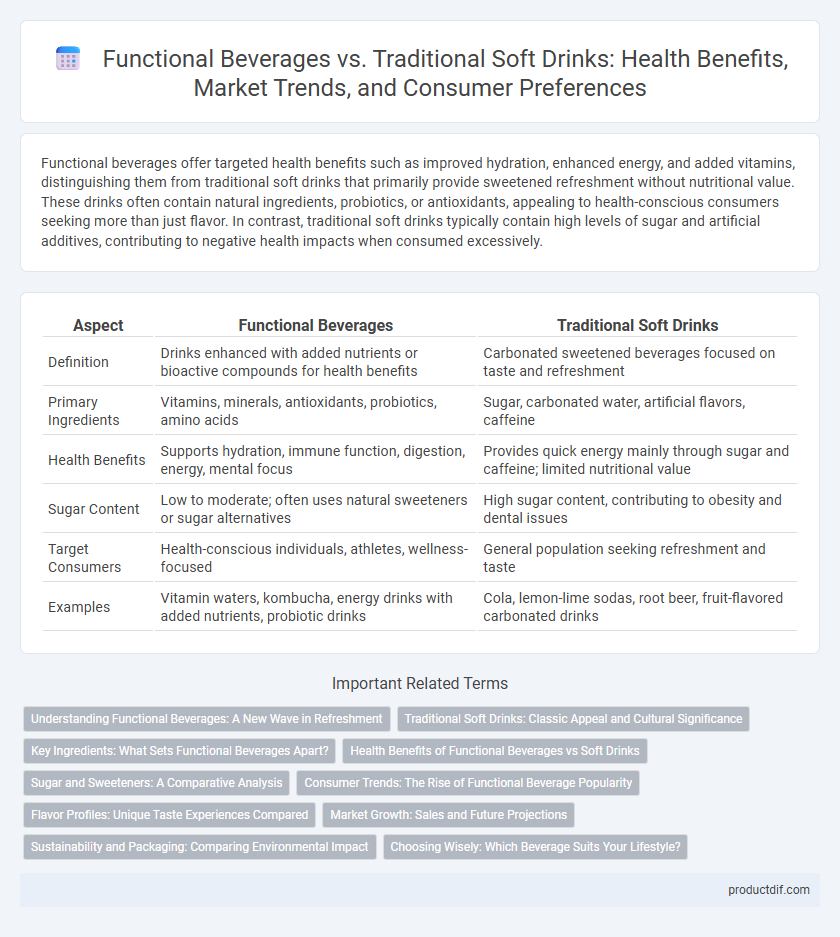Functional beverages offer targeted health benefits such as improved hydration, enhanced energy, and added vitamins, distinguishing them from traditional soft drinks that primarily provide sweetened refreshment without nutritional value. These drinks often contain natural ingredients, probiotics, or antioxidants, appealing to health-conscious consumers seeking more than just flavor. In contrast, traditional soft drinks typically contain high levels of sugar and artificial additives, contributing to negative health impacts when consumed excessively.
Table of Comparison
| Aspect | Functional Beverages | Traditional Soft Drinks |
|---|---|---|
| Definition | Drinks enhanced with added nutrients or bioactive compounds for health benefits | Carbonated sweetened beverages focused on taste and refreshment |
| Primary Ingredients | Vitamins, minerals, antioxidants, probiotics, amino acids | Sugar, carbonated water, artificial flavors, caffeine |
| Health Benefits | Supports hydration, immune function, digestion, energy, mental focus | Provides quick energy mainly through sugar and caffeine; limited nutritional value |
| Sugar Content | Low to moderate; often uses natural sweeteners or sugar alternatives | High sugar content, contributing to obesity and dental issues |
| Target Consumers | Health-conscious individuals, athletes, wellness-focused | General population seeking refreshment and taste |
| Examples | Vitamin waters, kombucha, energy drinks with added nutrients, probiotic drinks | Cola, lemon-lime sodas, root beer, fruit-flavored carbonated drinks |
Understanding Functional Beverages: A New Wave in Refreshment
Functional beverages offer enhanced health benefits through ingredients like probiotics, vitamins, and antioxidants, setting them apart from traditional soft drinks that primarily provide sweetness and carbonation. These drinks support hydration, digestion, and immune function, appealing to health-conscious consumers seeking more than just flavor. Rising market demand reflects a shift towards wellness-focused refreshment options over conventional sugary sodas.
Traditional Soft Drinks: Classic Appeal and Cultural Significance
Traditional soft drinks have maintained a classic appeal due to their iconic flavors, such as cola, root beer, and lemon-lime, that evoke nostalgia and cultural heritage across generations. These beverages play a significant role in social rituals, celebrations, and regional identities, reinforcing their cultural significance globally. The consistent demand for traditional soft drinks demonstrates enduring consumer loyalty despite the growing trend towards functional beverages targeting health and wellness.
Key Ingredients: What Sets Functional Beverages Apart?
Functional beverages distinguish themselves from traditional soft drinks through key ingredients such as probiotics, adaptogens, vitamins, and antioxidants, which provide targeted health benefits beyond hydration. Unlike traditional soft drinks that primarily contain high sugar levels and artificial flavors, functional drinks often incorporate natural botanicals, herbal extracts, and nutrient-dense superfoods designed to support immunity, digestion, and mental clarity. This strategic formulation places functional beverages at the forefront of health-conscious consumer trends seeking functional efficacy rather than just refreshment.
Health Benefits of Functional Beverages vs Soft Drinks
Functional beverages offer enhanced health benefits by containing added vitamins, minerals, probiotics, and antioxidants that support immune function, digestion, and hydration. Traditional soft drinks primarily consist of high sugar content and artificial additives, which can contribute to obesity, diabetes, and dental problems. Consumers seeking improved wellness often prefer functional beverages for their nutrient density and potential to promote overall health.
Sugar and Sweeteners: A Comparative Analysis
Functional beverages often contain lower sugar levels and incorporate natural sweeteners like stevia or monk fruit, targeting health-conscious consumers seeking reduced calorie intake. Traditional soft drinks typically have high sugar content, with averages around 39 grams per 12-ounce serving, contributing to concerns about obesity and diabetes. The comparative analysis highlights a shift towards functional beverages that emphasize sugar alternatives and added nutrients, aligning with growing demand for healthier drink options.
Consumer Trends: The Rise of Functional Beverage Popularity
Functional beverages have surged in popularity due to increasing consumer demand for health-conscious options enriched with vitamins, minerals, probiotics, and antioxidants. Unlike traditional soft drinks, which primarily offer sweetness and carbonation, functional beverages target specific wellness benefits such as improved digestion, enhanced energy, and immune support. Market data shows a robust growth rate in the functional beverage sector, driven by millennials and Gen Z seeking natural, low-sugar alternatives that align with holistic lifestyles.
Flavor Profiles: Unique Taste Experiences Compared
Functional beverages offer a diverse range of flavor profiles enriched with natural botanicals, herbs, and superfoods, creating unique taste experiences that differ significantly from traditional soft drinks' sweet and often artificial flavor compositions. These drinks often balance subtle bitterness, earthiness, and refreshing citrus notes, providing complexity designed to complement their health benefits. In contrast, traditional soft drinks emphasize bold, sugary flavors with carbonation and familiar fruit or cola essences that prioritize immediate sweetness and refreshment over nuanced taste layers.
Market Growth: Sales and Future Projections
The global functional beverages market is projected to grow at a CAGR of over 7% from 2024 to 2030, driven by rising consumer demand for health-enhancing ingredients like probiotics, antioxidants, and vitamins. In contrast, traditional soft drink sales have experienced stagnant growth due to increasing health concerns and shifting preferences towards low-sugar and natural options. Market analysis indicates functional beverages will capture a larger share of the beverage industry, with North America and Asia-Pacific leading future expansion fueled by innovation and wellness trends.
Sustainability and Packaging: Comparing Environmental Impact
Functional beverages typically utilize biodegradable or recyclable packaging materials, reducing environmental impact compared to traditional soft drinks that often rely on single-use plastic bottles. The production of functional beverages emphasizes sustainable sourcing and lower carbon footprints through natural ingredients and eco-friendly processing methods. Traditional soft drinks contribute significantly to plastic waste pollution, whereas functional beverage brands are increasingly adopting circular economy principles to minimize packaging waste.
Choosing Wisely: Which Beverage Suits Your Lifestyle?
Functional beverages, enriched with vitamins, minerals, and probiotics, provide targeted health benefits that support hydration, digestion, and energy levels, making them ideal for health-conscious consumers. Traditional soft drinks, high in sugar and artificial additives, often contribute to increased calorie intake and potential metabolic issues. Selecting the right beverage depends on lifestyle goals such as maintaining energy, enhancing wellness, or occasional indulgence within a balanced diet.
Functional Beverages vs Traditional Soft Drinks Infographic

 productdif.com
productdif.com